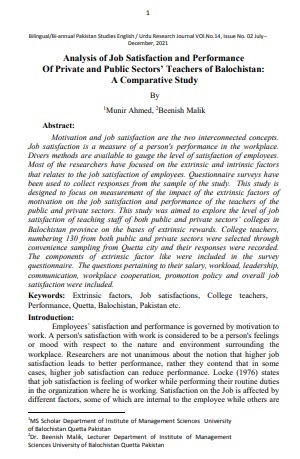Analysis of Job Satisfaction and Performance of Private and Public Sectors’ Teachers of Balochistan: A Comparative Study
Keywords:
Extrinsic factors, Job satisfactions, College teachers, Performance, Quetta, Baluchistan, Pakistan etcAbstract
Motivation and job satisfaction are the two interconnected concepts.
Job satisfaction is a measure of a person's performance in the workplace.
Divers methods are available to gauge the level of satisfaction of employees.
Most of the researchers have focused on the extrinsic and intrinsic factors
that relates to the job satisfaction of employees. Questionnaire surveys have
been used to collect responses from the sample of the study. This study is
designed to focus on measurement of the impact of the extrinsic factors of
motivation on the job satisfaction and performance of the teachers of the
public and private sectors. This study was aimed to explore the level of job
satisfaction of teaching staff of both public and private sectors‟ colleges in
Balochistan province on the bases of extrinsic rewards. College teachers,
numbering 130 from both public and private sectors were selected through
convenience sampling from Quetta city and their responses were recorded.
The components of extrinsic factor like were included in the survey
questionnaire. The questions pertaining to their salary, workload, leadership,
communication, workplace cooperation, promotion policy and overall job
satisfaction were included.
References
Adams, G.A., Kiang, L.A., and King, D.W., 1996. Relationship of job and
Family Involvement, Family Social Support and work. Family conflict
with job and life satisfaction Journal of Applied Psychology, 81:411-
Arches, J., 1991. Social Structure, Burnout and Job Satisfaction. Social Work,
:193-272 Blood, R.O., and Wolfe, D.M., 1960. In Hubands and
wives. Macmillan, New York.
Bowling, N.A., 2007. Is the job satisfaction – Job performance. Relationship
spurious. A Meta – Analytic examination. Journal of Vocational
Behavior, 71:167-185.
Dex, S., and Scheible, F., 1999. Businey Performance and Family – Friendly
Policies. Journal of General Medicine, 24:22-37.
DiMatteo, M.E., Sherbourne, C.D., Hays, R.D., Ordway, L., Kravitz, R.L.,
McGlynn, E.A.,1993. Physicians, characteristics influence patients,
adherence to medical treatment; results from the Medical Outcomes
Study. Health Psychology, 12:93-102.
Fingegold, D., Mohrman, S., and Spreitzer, G.M., 2002. Age effects on the
predictions of Technical works commitment and willingness to
turnover: Journal of Organizational Behavior, 23:655-674.
Halvorsen, P.A., Kristiansex, I.S., Aashlon, O.G., Forde, O.H., 2003. Medical
doctors perception of the number needed to treat (NNT).
Scandanavian Journal Primary Health Care, 21: 162 – 166.
Janus, K., Amelung, V.E., Gaitanides, M., Schwartz, F.W., 2007. German
physicians ―on strike‖— shedding light on the roots of physician
dissatisfaction. Health Policy, 82:357-65.
Judge, T.A., Heller, D., & Mount, M. K. 2002. Five factor model of
personality and job satisfaction: A meta-analysis. Journal of Applied
Psychology, 87:530-541.
Judge, T.A., Thoresen, C.J., Bono, J.E., and Patton, G.K., 2001. The Job
satisfaction – Job performance relationship. A qualitative and
quantitative review. Physchogical Bulliton, 127:376-407.
Kaur, S., Sharma, R., Talwar, R-Verma, A., Singh, A., 2009. A study of job
satisfaction and work environment perception among doctors. Journal
of Medical Science, 63: 139 – 144.
Kinzl, J.F., Knotger, H., Traweger, C., Ledderer , W., Heideggs, T., and
Benze, A., 2005. Influence of working conditions on job satisfaction
in anaesthetists. British Journal Anaesthesia, 94:211-215.
Krishnan, S.K., & Shigh., M., 2010. Outcomes of Insertion to quit of Indian
IT professionals. Human Resource Management, 49:419-435.
Larson, J.H., Wilson, S.M., and Beley, 1994. The impact of job insecurity on
marital and family relationships Journal of Family Relation, 43:138 –
Locke, E.A., 1976. The nature and cause of job satisfaction: Hand book of
Industrial and organizational Psychology. Rand. MC Nally, Chicago
IL. 349.
Locke, L.A., 1969. What is job satisfaction? Organizational Behavior and
Human Performance, 4: 309-336
Piotrkowski, C., 1979. Work and the Family Systeem, the Free Press, New
York.
Ramsay, H., 1999. ―Close Encounters of the Nerd Kind‖, Paper Presented at
the Work Life, 2000 Program, Sweden.
Scandura, A., and Lankau, M.J., 1997. ―Relationships of Gender, Family
Responsibility and Flexible Work Hours to Organizational
Commitment and Job Satisfaction‖, Journal of Organizational
Behavior, 18 : 377-391.
Scholarios, D., and Marks, A., 2004. Work-Life Balance and the Software
Workers‖, Human Resource Management Journal, 14:54-74.
Shetty, K., and Bhattacharya, J., 2007. Summries for patients‘ .changes in
hospital mortality after regulations to restrict resident doctors work
hours. Annals of Internal Medicine, 147: 116.
Spreitzer, G.M., 2002. Age effects on the predictions of Technical works
commitment and willingness to turnover: Journal of Organization
Behavior, 23:655-674.test of an integrated Model. Human Relations,
:1205-1230.
Wada, K., Arimalsu, M., Higashi, T., Yoshikawa, T., Ods, S., Taniguchi, H.,
Kawashina, M., and Aizawa, Y., 2009. Physician Job satisfaction and
Warlay Condiats in Japan. Journal Occupational Health, 51: 261 –
Wright, T.A., and Cropanzano, 1998. Emotional exhaustion as a predictor of
job performance and voluntary Turnover. Journal of Applied
Psychology, 83:486.493.



